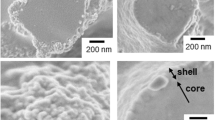Abstract
Utilizing the concurrence of polymerization-induced phase separation and sol-gel transition in the hydrolytic polycondensation of alkoxysilanes, a well-defined macroporous structure is formed in a monolithic wet gel. By exchanging the fluid phase of the wet gel with an appropriate external solution, the nanometer-range structure of the wet gel can be reorganized into structures with larger median pore size essentially without affecting the macroporous framework. The double-pore structure thus prepared is characterized by open pores distributed in discrete size ranges of micrometers and nanometers. A new type of chromatographic column (silica rod) has been developed using monolithic double-pore silica instead of packed spherical gel particles. Typical silica rod columns had significantly reduced pressure drops and improved analytical efficiencies which do not deteriorate even at higher sample flow rates, both arising from a greater macropore volume than particle packed columns.
Similar content being viewed by others
References
R.K. Iler, The Chemistry of Silica (Wiley, New York, 1979), chap. 5.
S. Liu and L.L. Hench, in Sol-Gel Optics II, edited by J.D. Mackenzie (SPIE—The International Society for Optical Engineering, Washington, 1992), Vol. 1758, p. 14.
K. Nakanishi, H. Kaji, and N. Soga, Ceramic Transactions—“Porous Materials,” edited by K. Ishizaki et al. (The American Ceramic Society, Ohio, 1993), Vol. 31, pp. 51–60.
K. Nakanishi, J. Porous Mater. 4, 67–112 (1997).
N. Tanaka, H. Kinoshita, M. Arakiand, and T. Tsuda, J. Chromatogr. 332, 57–69 (1985).
H. Minakuchi, K. Nakanishi, N. Soga, N. Ishizuka, and N. Tanaka, Anal. Chem. 68, 3498–3501 (1996).
K. Nakanishi, H. Komura, R. Takahashi, and N. Soga, Bull Chem. Soc. Jpn. 67, 1327–1335 (1994).
K. Nakanishi and N. Soga. J. Am. Ceram. Soc. 74, 2518–2530 (1991).
K. Nakanishi and N. Soga. J. Non-Cryst. Solids 139, 1–24 (1992).
H. Minakuchi, K. Nakanishi, N. Soga, N. Ishizuka, and N. Tanaka, J. Chromatogr. A 762, 135–146 (1997).
K. Nakanishi, N. Koheiya, and N. Soga, unpublished data.
G. Guiochon, in Cs. Horvath (Ed.), High Performance Liquid Chromatography—Advances and Perspectives Academic Press, New York, 1980), Vol. 2, pp. 1–56.
S. Hjerten, J.-L. Liao, and R. Zhang, J. Chromatogr. 473, 273–275 (1989).
Q.-C. Wang, F. Svec, and J.M.J. Frechet, Anal. Chem. 65, 2243–2248 (1993).
R.P.W. Scott, Liquid Chromatography Column Theory (John Wiley & Sons, Chichester, 1992), chap. 7.
P.A. Bristow and J.H. Knox, Chromatographia 10, 279–289 (1977).
Author information
Authors and Affiliations
Rights and permissions
About this article
Cite this article
Nakanishi, K., Minakuchi, H., Soga, N. et al. Structure Design of Double-Pore Silica and Its Application to HPLC. Journal of Sol-Gel Science and Technology 13, 163–169 (1998). https://doi.org/10.1023/A:1008644514849
Issue Date:
DOI: https://doi.org/10.1023/A:1008644514849




